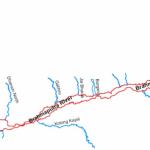- The main water divide in Peninsular India is formed by the Western Ghats, which runs from north to south close to the western coast.
- Most of the major rivers of the Peninsula flow eastwards and drain into the Bay of Bengal.
- These rivers make deltas at their mouths.
- There are numerous small streams flowing west of the Western Ghats.
- The Narmada and the Tapi are the only long rivers, which flow west and make estuaries.
- The drainage basins of the peninsular rivers are comparatively small in size than the Himalayan rivers.
- Two types of peninsular rivers:
- West Flowing: Narmada, Tapi
- East Flowing: Damodar, Subarnrekha, Mahanadi, Godavari, Krishna, Kaveri West Flowing Rivers
The Narmada Basin (aka Rewa) Peninsular
- It rises in the Amarkantak hills in Madhya Pradesh.
- It flows towards the west in a rift valley formed due to faulting.
- All its tributaries are very short and most of these join the main stream at right angles.
- Its basin extends over the states of Madhya Pradesh, Gujarat, Maharashtra.
- It is bounded by the Vindhyas on the north, by the Maikala range on the east, by the Satpuras on the south, and by the Arabian Sea on the west
- The Sardar Sarovar Dam is on the river in the state of Gujarat.
- It enters Arabian Sea near Bharuch in Gujarat. Aaliya Bet island is situated on its mouth.
- Dhuandhar falls in Madhya Pradesh
The Tapi Basin Peninsular
- It rises in the Satpura ranges (Betul plateau) in Madhya Pradesh
- It also flows in a rift valley parallel to the Narmada but it is much shorter in length.
- It flows south of the Satpuras.
- It covers parts of Madhya Pradesh, Maharashtra and Gujarat.
- Its mouth is located at Surat, Gujarat.
- Purna river is its important tributary.
Sabarmati
- It originates in Aravallis, Rajasthan.
- After reaching Gujarat, it drains into the Arabian Sea.
Mahi
- It rises in Madhya Pradesh and after flowing through the Vagad region of Rajasthan, enters Gujarat and flows into the Arabian Sea.
Mandovi (Mhadei) & Zuari river
- Both originate in Western Ghats.
- They are important rivers of Goa and merge with the Arabian Sea.
West Flowing rivers of Karnataka
- Kalinadi
- Sharavati- Jog Falls (aka Gerosoppa Falls or Jogada Gundi) is located on this river..
- Netravati
West Flowing rivers of Kerala
- Periyar- It merges into Vembanad Lake. Source is in Tamil Nadu
- Pamba/ Pampa- empties into the Vembanad Lake. Originates in Western Ghats.
- Bharathpuzha
The coastal plains between Western Ghats and the Arabian Sea are very narrow. Hence, the coastal rivers are short.
East Flowing Rivers
Damodar
- West bengal + Jharkhand
- Source: Chota Nagpur Plateau, Jharkhand
- Barakar is an important tributary which also originates from the Chota Nagpur Plateau.
- It meets Damodar in West Bengal.
- The river merges into Sunderbans
- The region is well known for it Iron & Steel industry.
Subarnrekha
- It originates from Ranchi plateau.
- Flows through Jharkhand, West Bengal, Odisha.
- It merges with the Bay of Bengal in Odisha.
Baitarni
- It originates from the Garhjat Hills of Odisha ( on the southern edge of Chota Nagpur Plateau)
- It flows into the Bay of bengal
Brahmani ( Peninsular )
- It is a major seasonal river of Odisha.
- It is formed by the confluence of the Sankh and the South Koel rivers originating from the Chota Nagpur Plateau.
Mahanadi
- It rises in the highlands of Chattisgarh (Dandkaranya).
- It flows through Odisha to reach the Bay of Bengal.
- Left Bank Tributaries- Seonath, Mand, Ib, Hasdeo
- Left Bank Tributaries- Ong, Jonk, Telen
- The Hirakud Dam is built across the river.
- It is also known for Talcher Thermal Power Plant
Rushikulya
- Source: Nayagarh Hills (Odisha)
- Its mouth is a well known hatching site for Olive Ridley Turtles.
- They live in only warm tropical waters of Pacific, Atlantic and the Indian Ocean.
- These small turtles are highly endangered.
- They are known for their unique mass nesting called ” Arribada”. In this process, thousands of females come together on the same beach to lay eggs.
- Odisha’s Ganjam coast is the largest mass hatching site of Olive Ridley Turtles in the world.
Godavari
- It is the largest peninsular river.
- It rises from the slopes of the Western Ghats in the Nasik district of Maharashtra.
- Its length is about 1500 Km.
- It drains into the bay of Bengal.
- Its drainage basin is also the largest among the peninsular rivers.
- It covers parts of Maharashtra (> 50%), Madhya Pradesh, Odisha and Andhra Pradesh and Telangana
- It is also known as Dakshin Ganga.
- Left Bank tributaries- Penganga, Wardha, Wenganga (all three together form Pranhita), Indravati, Banganga, Kadva, Shivana, Purna, Kadam, Taliperu, Sabari
- Right Bank tributaries- Nasardi, Darna, Pravara, Sindphana, Manjira, Manair, Kinnerasani
Krishna
- It rises from a spring near Mahabaleshwar, Maharashtra.
- Its drainage basin is shared by Maharashtra, Karnataka, Andhra Pradesh and Telangana
- Left Bank Tributaries: Bhima (chandrabhaga river), Dindi, Peddavagu, Haliya, Musi, Paleru, Munneru
- Right Bank Tributaries: Venna, Koyna, Panchganga, Dudhaganga, Ghataprabha, Malaprabha, Tungabhadra
Penneru ( Peninsular )
- It rises from the Nandi Hills in Karnataka.
- It flows through Karnataka and Andhra Pradesh
- Left Bank Tributaries: Jayamangali, Kunderu, Sagileru
- Right Bank Tributaries: Chitravati, Papagni, Cheyyeru,
Kaveri
- It rises in the Brahmagiri range of the Western Ghats and reaches the Bay of Bengal via Tamil Nadu.
- Its basin drains part of Karnataka, Kerala and Tamil Nadu.
- Left Bank Tributaries: Hemavati, Shimsha, Arkavathy
- Right Bank Tributaries: Kabini, Bhavani, Noyyal, Amaravati
- Sivasamudram waterfall is located on Kaveri
Vaigai River
- It originates in Varusanadu Hills of Tamil Nadu.
- Madurai is located on the banks of the river.
- It empties into the Palk Strait.
- The Vattaparai Falls are located on this river.
Read More: Indian River System











